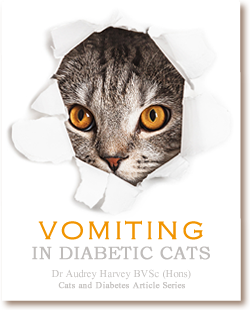Vomiting in Diabetic Cats
Written by: Dr Audrey Harvey BVSc (Hons)
 It’s not difficult to recognize the more common diabetes symptoms in cats. They drink a lot of water, urinate more frequently and lose weight. Treatment of diabetes involves regular injections of insulin to keep blood glucose levels within normal limits.
It’s not difficult to recognize the more common diabetes symptoms in cats. They drink a lot of water, urinate more frequently and lose weight. Treatment of diabetes involves regular injections of insulin to keep blood glucose levels within normal limits.
Vomiting isn’t one of the most common feline symptoms of this disease. Having said that, if a cat is being treated for feline diabetes, vomiting is definitely something to watch out for. It can indicate that their blood glucose is not being well controlled, and they may be developing diabetic ketoacidosis. This is a potentially fatal condition that needs urgent veterinary treatment. However, if a diabetic cat starts throwing up, it doesn’t necessarily mean that their diabetes is worsening. Other symptoms of diabetic ketoacidosis to look for are increased thirst, loss of appetite and extreme lethargy.
Another reason for diabetic vomiting in cats is pancreatitis. This condition can be hard to diagnose in our feline family members but should always be considered when cat vomiting in a diabetic pet becomes a problem. Some veterinarians believe that up to one half of all cases of diabetes in cats are accompanied by a low grade chronic inflammation of the pancreas. When they have a flare up, it can reduce their appetite and make them vomit. They need to be closely monitored until they recover because the change in their food intake will affect the amount of insulin they need.
Don’t forget that there are many other cat vomiting causes that are totally unrelated to diabetes. Some examples include gastroenteritis, kidney disease and inflammatory bowel disease. Because a diabetic cat has an underlying chronic medical condition, any illness will need a thorough investigation including comprehensive blood tests and possibly x-rays. If their vet suspects inflammatory bowel disease, the only way to confirm this is with a biopsy of the intestinal wall.
There are three parts to treating diabetic vomiting in cats. Firstly, their blood sugar levels need to be checked to make sure that the vomiting isn’t due to diabetic ketoacidosis. Secondly, the main cause of the vomiting must be diagnosed and treated appropriately. This may involve medication for inflammatory bowel disease or pain relief and antibiotics for pancreatitis. Lastly, intravenous fluids and anti-vomiting drugs such as Cerenia or Maxolon can be used to support the cat as they recover.
When the cat has stopped throwing up, they can start eating small amounts of a low carbohydrate food. Ideally, it should be a canned food with less than 7% carbohydrates. They will need to have another glucose curve done, to make sure their insulin dose is correct. It is possible that the signs and symptoms of diabetes return until their blood glucose is again stabilized.
If a cat is vomiting for more than a day, they should be taken to their veterinarian for a checkup. Whether they are a diabetic or not, vomiting can lead to dehydration and electrolyte imbalances. An early diagnosis means that treatment can start quicker, and they will be back in good health sooner.
